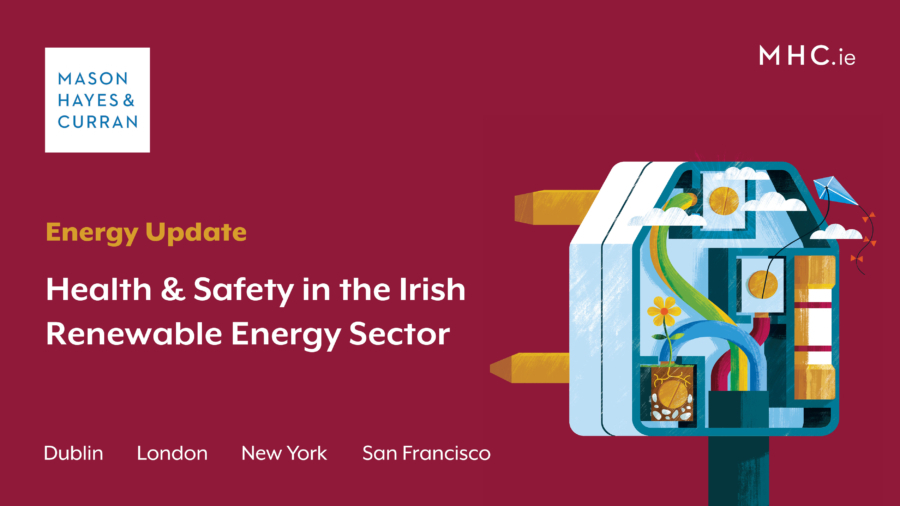Health & Safety in the Irish Renewable Energy Sector

The Health and Safety Authority of Ireland is presently carrying out an inspection campaign on the Irish renewable energy sector. Our Planning & Environment team explores the health and safety obligations on developers of renewable energy projects and consider steps they can take to ensure compliance with the law.
In a previous article, we flagged that the Health and Safety Authority (HSA) is carrying out an unprecedented inspection campaign of the renewable energy sector in Ireland. The campaign is expected to focus on wind farms, solar farms and anaerobic digestion facilities. We highlighted the key hazards that inspectors will be looking out for and what operators should do to reduce the risk of enforcement action being taken against them. In this article, we review some further health and safety obligations, of which developers should be mindful.
The renewable energy sector is playing an increasingly important part in the generation of Ireland’s electricity. The largest amount of renewable energy is harnessed from wind energy, with over 300 onshore wind farms now generating renewable energy across the country. Under the Climate Action Plan 2024, it is intended that onshore wind farms will continue to be the dominant source of renewable energy. However, the Government is also targeting significant expansion of solar farms and offshore wind farms. This means renewable energy operations will be located across an even wider variety of sites and locations. The type of site or location can throw up different challenges in ensuring the health and safety of persons working on a project. In addition, different health and safety obligations can arise for developers and operators depending on whether a project is at construction or operational stage.
Construction of renewable energy projects
The design and construction of renewable energy projects is a significant undertaking. In addition to the assembly of the energy harnessing infrastructure, projects often include the installation of associated equipment such as substations, grid connection cables, etc. Different infrastructure is also needed depending on the type of generation technology deployed. For example, onshore wind turbines are usually located in isolated, mountainous areas, while solar farms can be located in lowland areas, and offshore wind farms are located in the sea. Each type of project requires different infrastructure for accessing the site. For instance, onshore wind farms often require access roads and tracks to be built or strengthened before major construction works can begin.
Different risks will arise depending on the type of project. All construction works, however, are governed by the Safety, Health and Welfare at Work Act 2005 (as amended) and by the Safety, Health and Welfare at Work (Construction) Regulations 2013. Under the Regulations, the definition of “construction works” includes commissioning, repair, upkeep, de-commissioning, demolition and dismantling. Therefore, developers and operators should be mindful that the obligations related to construction works under the Regulations may continue throughout the operational and decommissioning stages of a project.
Appointment of supervisors
Under the Regulations, where a project involves works with particular risks to health and safety as set out in Schedule 1 of the Regulations, developers have certain health and safety obligations separate from the obligations of an appointed contractor. The type of works set out in Schedule 1 include works which put workers at risk of:
- Falling from a height
- Burial under earthfalls
- Works near high-voltage power lines
- Works exposing workers to the risk of drowning, and
- Works involving the assembly or dismantling of heavy prefabricated components
As a result, developers of renewable energy projects have health and safety obligations separate to the health and safety obligations of appointed contractors.
For example, regarding the design and management of a project, a developer is required to appoint, in writing, a competent project supervisor for the design process and a competent project supervisor for the construction stage. A developer may, however, choose to take on these roles itself provided it has the competence to do so. The developer must obtain written confirmation of acceptance of each of these appointments from the appointed supervisors.
Maintenance of Safety File
Following the appointment of a contractor to construct a project, a developer must maintain a safety file for each project. This must include information regarding the state or condition of any structure. The standard of knowledge a developer is assumed to have in this regard is that information which is in the developer’s possession or which could be obtained by the developer making reasonable enquiries. The safety file must be kept available for inspection by the contractor or other persons having health and safety obligations connected with the project. The developer must co-operate with the project supervisors to enable them to also comply with the Regulations.
Notification of works to the HSA
Where construction works are planned to last longer than 30 working days, or the volume of work is scheduled to exceed 500 person days, a developer is required to give prompt notice in writing to the HSA in an approved form containing particulars of the project supervisors appointed for the design and construction stages of the project.
Duties of project supervisors
If a developer chooses to take on the role of project supervisor for either or both the design and/or construction stage of a project, then it will assume the role and responsibilities of a project supervisor under the Regulations. These include, among other matters:
- The preparation, maintenance and implementation of a written ‘safety and health plan’ for the project
- Designing the project and coordinating works in accordance with the general principles of prevention, and
- Directing contractors appropriately to ensure compliance with the safety and health plan
The project supervisor also has reporting requirements to notify the HSA of any non-compliance with a safety and health plan by a contractor.
CE marking of wind turbines
When sourcing wind turbines for a project, developers should ensure that the manufacturer of the wind turbine is compliant with its obligations under the European Machinery Directive (the Directive)[1] as transposed into Irish law by the European Communities (Machinery) Regulations 2008 (the Machinery Regulations).[2] This is because a wind turbine, including its tower, nacelle, hub, blades and all internal components, qualifies as “machinery” as defined in the Directive and the Machinery Regulations.
The Directive aims to guarantee a high level of protection for EU workers and citizens by harmonising health and safety standards across Member States. The duties on manufacturers, importers and distributors of machinery placed on the Irish market are set out in the Machinery Regulations. All compliant wind turbines should bear the ‘CE’ mark of assurance that they comply with the essential health and safety requirements. A declaration of conformity and a technical file on the health and safety specifications of the wind turbine should also be available from the manufacturer.
Operation of renewable energy projects
When a project is operational, regardless of whether it is operated remotely and/or is not permanently occupied, the project site is still considered a workplace. All persons who have control to any extent over the project site have duties to ensure, so far as reasonably practicable, that the project does not pose a risk to persons working there or to anyone else who may be affected by activities on site.
These include duties regarding construction works under the Regulations, as noted previously. They also include duties under the Act to ensure the provision of a safe place of work. In addition to carrying out mandatory risk assessments and preparing safety statements, operators must ensure they implement safe working practices. Some examples of this are:
- Ensure all workers understand the safety statement and safe operating procedures
- Ensure all work is properly planned and carried out by a competent person
- Provide appropriate work equipment and personal protective equipment
- Provide appropriate and up to date training to workers on work practices, and
- Ensure workers comply with safety systems
This is a non-exhaustive list intended for illustrative purposes only. Operators must tailor their safety systems to their specific operations.
Contractual obligations
At each stage of the construction, operational and decommissioning process, developers, site owners, contractors and operators will need to carefully consider any contractual allocation of health & safety responsibilities and liability. “Concurrent wrongdoers” may find themselves being jointly and severally liable. This means a defendant with minimal responsibility may find themselves liable for the full amount of any judgment, especially where other parties have become insolvent.
Comment
The HSA’s inspection campaign is a timely reminder to developers to ensure they are compliant with their health and safety obligations. Developers should be mindful that appointing a contractor to carry out the construction of a project does not absolve it of all responsibilities related to health and safety. Developers should also ensure that suppliers of wind turbines and any other machinery are compliant with their health and safety obligations. Operators should also be mindful that health and safety obligations continue during the operational phase. By being proactive on health and safety matters, developers and operators can reduce any potential liability they might have for injury caused to persons in connection with a project.
Please contact a member of our Planning & Environment team if you would like to discuss this area in further detail.
[1] Directive 2006/42/EC of the European Parliament and of the Council of 17 May 2006 on machinery, and amending Directive 95/16/EC (recast)
[2] SI No 407/2008 - European Communities (Machinery) Regulations 2008
Share this:






